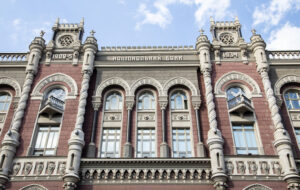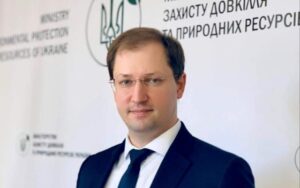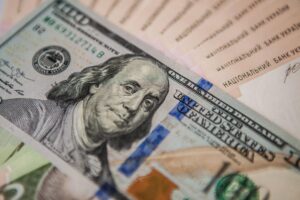
In May 2023 state-owned PrivatBank again topped the list of the most profitable banks with UAH 4 billion 597.1 million net profit, followed by the bank with Ukrainian capital FUIB with UAH 756.4 million.
According to the data published by the National Bank of Ukraine on its website, in the top five banks with the greatest net profit in May there are also three banks with foreign capital: Ukrsibbank – UAH 577.7 million, OTP Bank – UAH 560.8 million and Raiffeisen Bank – UAH 436.4 million.
The second top five banks were state-owned Ukrgasbank and Ukreximbank (UAH 376.2 mln and UAH 292.5 mln, respectively) and banks with foreign capital: Citibank (UAH 324.0 mln), Credit Agricole Bank (UAH 301.1 mln), and Credobank (UAH 231.2 mln).
Four more banks made profit ranging from 200m UAH to 100m UAH: Pivdenniy Bank – 168.6m UAH, Oshchadbank – 160.8m UAH, Universal Bank (mono) – 149.4m UAH, and ING Bank Ukraine – 139.4m UAH.
Among these 14 banks, the largest reserves in May were disbanded Ukrexim – 1 billion 253.2 million UAH and Oschadbank – 315.8 million UAH, while the largest new reserves were formed by Privat – 784.0 million UAH and Raif – 647.2 million UAH.
The list of 9 unprofitable banks in May was headed by Motor Bank – 12.8 million UAH and First Investment Bank – 9.5 million UAH, while the rest of the banks have less than 5 million UAH.
In May, the net profit of banks decreased to 9.59 billion UAH from 9.94 billion UAH in April and 12.58 billion UAH in March, which, however, is more than 6.61 billion UAH in February. Excluding Privat, the net profit of the banks in May was UAH 5.35 billion against UAH 5.52 billion in April.
At the same time if in April total assets of all banks increased by 61.53 billion UAH, in May – only by 2.23 billion UAH due to decrease of Privat by UAH 16.88 billion, Raif – by UAH 7.26 billion, and OTP – by UAH 5.04 billion.
The leaders in increase of assets in May were Ukrgas – UAH 6.90 billion, City – UAH 3.80 billion, FUIB – UAH 3.38 billion, Credit Agricole – UAH 3.35 billion, and Pivdenniy Bank – UAH 2.97 billion.
According to May results, this increase in assets allowed Crédit Agricole to enter the top ten largest Ukrainian banks with UAH 96.74 bn., leaving behind Sense-Bank (former Alfa-Bank), whose assets decreased by UAH 0.55 bn. in May and reached UAH 96.64 bn. We remind that at the beginning of 2022, Alfa Bank was the 6th largest bank by assets on the market with UAH 125.36 bln.
Increase of obligatory reserves in May caused increase of UAH 13.26 bn. in bank portfolios after decrease by UAH 5.39 bn. in April.
Raif increased its portfolio the most, by UAH 6.19 bln, Ukrsib by UAH 4.75 bln, Oschad by UAH 3.03 bln, Citi by UAH 1.20 bln, and ING Bank by UAH 0.90 bln.
In general, according to the results of five months of the year the most profitable bank by a wide margin remains PrivatBank – UAH 25.48 billion, or 47.5% of the total net profit of the banking system for the period.
In January-May, Raif received UAH 3.26 billion in net profit, FUIB – UAH 2.99 billion, Ukrsibbank – UAH 2.89 billion, OTP Bank – UAH 2.60 billion, City – UAH 2.27 billion, Oschad – UAH 2.23 billion and UKrgas – UAH 2.18 billion.
Among the 11 banks, whose net profit for the five months exceeded 1 billion UAH, also Ukrexim – 1.54 billion UAH, Sens-Bank – 1.40 billion UAH and Universal (mono) – 1.31 billion UAH.

Ukrainian and Polish presidents Volodymyr Zelenskyy and Andrzej Duda have met in Lutsk (Volyn Region).
A photo of the presidents in the Church of Saints Peter and Paul in Lutsk was published by the “Suspicious” telegraph channel.
The website of the Polish presidential office also published a photo from the church with the presidents. “Together we pay tribute to all those innocently killed in Volyn! We are united by memory! Together we are stronger,” they wrote.
In the telegram channel of the president of Ukraine also published photos of the meeting of Zelensky and Duda with a similar inscription: “Together we honor all the innocent victims of Volyn! The memory unites us! Together we are stronger!”.
Earlier it was reported that in July Ukraine and Poland will hold a series of events on the 80th anniversary of the Volyn tragedy.

One day of Russian military aggression costs €102 million or 4 billion hryvnia of damage to the Ukrainian environment, Minister of Environmental Protection and Natural Resources Ruslan Strilets said on Saturday.
“1 day of the great war = 102 million euros or 4 billion hryvnia of environmental damage. And that’s without taking into account Russia’s ecocide at the Kakhovka hydroelectric power plant,” the government portal quoted Strilets as saying.
He noted that every day inspectors of the State Ecological Inspectorate of Ukraine record the destruction of the environment from hostilities, large losses of natural resources continue.
“Today there are already about 51 billion euros or 2 trillion hryvnias of environmental damage. This means that every day of war costs Russia at least 102 million euros or 4 billion hryvnias of environmental damage,” the minister believes.
Strilets said that the aggressor country must pay for all the damage caused, and to this end, Ukraine is working on the recognition of ecocide in international law.

Net sales of dollars by the National Bank of Ukraine (NBU) in the first week of July totaled $471.9 million, compared to $520.4 million in the last week of June.
According to the NBU on its website, from July 3 to 7, 2023, its purchase of currency decreased from $12.6 million to $6.7 million, while the sale went from $533.0 million to $478.5 million.
On the cash market, the dollar depreciated by about 5 kopecks during the week. – Up to UAH 37.20 per $1.
Since the beginning of the year, the NBU bought $184.6 mln at the market, while it sold $12.934.4 mln.
As we reported, the volume of interventions of the National Bank in June decreased to $1.80 billion from $1.93 billion in May.
However, due to significant inflows of external financing, international reserves grew by 4.5% in June to $39.00bn.

The first stage of the currency restrictions easing roadmap includes minimizing the multiplicity of exchange rates, liberalizing trade operations and facilitating new loans and investments.
The National Bank of Ukraine released the relevant public version of the Strategy to Ease Exchange Restrictions, Transition to a More Flexible Exchange Rate and Return to Inflation Targeting on Friday evening.
According to it, the second stage is liberalization of trade finance, management of currency risks of banks, the possibility of repatriation of interest on “old” debt obligations and investments.
Finally, the third stage includes the possibility of repayment of loans and investments, liberalization of household transactions and transactions in derivatives, the possibility of lending to non-residents and investments abroad.
As announced by the National Bank, the Roadmap and the Strategy have no specific calendar dates.
“Softening of currency restrictions is carried out gradually, taking into account the above priorities and is determined not by timeframes, but by the formation of appropriate macroeconomic prerequisites,” said the NBU.
According to the document, although the Roadmap defines the sequence of easing of currency restrictions, some steps (in particular, within the specified stages) may be implemented earlier or later than initially envisaged. This could happen if the conditions are such that a deviation from the stipulated sequence would be determined to be more beneficial to the economy, the currency market and the financial system.
The National Bank added that the easing of currency restrictions could occur gradually, in particular by changing the limits, calibration of levels, etc.
The regulator noted that the Roadmap reflects the following priorities: easing restrictions on transactions related to the movement of goods and services, then – related to capital flows and, finally, with its own foreign currency in respect of transactions at the expense of purchased foreign currency.
The NBU stressed that it will follow the general approach in which the refusal to fix the exchange rate will precede a large-scale liberalization of capital flows. “For its part, the increase in exchange rate flexibility will be preceded by the relaxation of most currency restrictions on trade transactions and restrictions that distort the functioning of the foreign exchange market because of the multiplicity of exchange rates,” the central bank added.
The National Bank added that during the implementation of the Strategy it will maintain tight monetary conditions by maintaining a sufficiently high level of real interest rates, which will ensure sufficient attractiveness of hryvnia assets and thus minimize the risks to exchange rate stability with the abandonment of the exchange rate fixing regime and the easing of currency restrictions.
According to the strategy, the NBU will base its decisions on the dynamics of the following key parameters: inflation and inflation expectations; the level of international reserves and foreign exchange market stability; interest rates and financial stability parameters.
“The appropriate preconditions and positive result of the conducted analysis have already allowed the NBU to soften a number of currency restrictions in June. At the same time, the prerequisites for the next steps of the Strategy are still forming,” the regulator noted.

The size of the cyber insurance market could reach $50 billion by 2030, according to the third annual report on the topic by analysts at international insurance broker Howden, according to its website.
After a major market correction due to an increase in ransomware claims in 2020 and 2021 that more than doubled the cost of cyber protection, conditions began to stabilize last year as activity declined and more robust risk controls deterred or mitigated attacks.
However, the report notes that cyberspace is not standing still, and events in 2023 point to a nuanced market. That said, optimism about more favorable supply dynamics for insurance buyers (through improved underwriting efficiency for insurers) is tempered by resurgent ransomware activity, lingering concerns about potential systemic losses and capital availability.
According to the report, there was a significant increase in ransomware attacks in the first half of 2023, but disclosures from a number of carriers in the first quarter of 2023 suggest that this has not (yet) been accompanied by a corresponding increase in claims. This in turn points to the effectiveness of risk controls that make companies more resilient and support a more stable cyber insurance market. Terms are now softening, and buyers who have the right risk controls are rewarded with better prices and terms, the paper explains.
As for cyber insurance pricing, the cost of cyber insurance is now more commensurate with the cost of loss after the recent correction, according to Dan Leahy, deputy director of Howden, whose words are cited in the report, after going through the early stages of development, which often involve new, fast-growing lines of business.
“While there has been a decline in prices in the first half of 2023, the sustainability of this trend remains uncertain given the ubiquity of threats,” he added.
As noted, while risk awareness is growing everywhere, cyber insurance, in fact, remains a large corporate market at present, and “needs to work, especially with smaller companies.” This is supported by the example of France, where 85% of the premiums paid for cyber insurance in 2022 came from large companies. The remaining 15% came from mid-sized companies and SMEs, but they accounted for a disproportionate share of claims reported
The report indicates that the use of direct market reinsurance is the biggest differentiator between cyber and any other class, as approximately 45% of cyber premiums are currently ceded to reinsurers, broad bandwidth limitations apply and price adjustments in the reinsurance market also represent potential limitations.